
The Western Ghats is a mountain range that covers an area of 160,000 square kilometres (62,000 sq mi) in a stretch of 1,600 kilometres (990 mi) parallel to the western coast of the Indian peninsula, traversing the states of Kerala, Tamil Nadu, Karnataka, Goa, Maharashtra and Gujarat. It is a UNESCO World Heritage Site and is one of the eight hot-spots of biological diversity in the world. It is sometimes called the Great Escarpment of India. It contains a very large proportion of the country's flora and fauna, many of which are only found in India and nowhere else in the world. According to UNESCO, the Western Ghats are older than the Himalayas. They influence Indian monsoon weather patterns by intercepting the rain-laden monsoon winds that sweep in from the south-west during late summer. The range runs north to south along the western edge of the Deccan Plateau, and separates the plateau from a narrow coastal plain, called Konkan, along the Arabian Sea. A total of thirty-nine areas in the Western Ghats, including national parks, wildlife sanctuaries and reserve forests, were designated as world heritage sites in 2012 – twenty in Kerala, ten in Karnataka, six in Tamil Nadu and four in Maharashtra.

The purple frog is a frog species belonging to the family Sooglossidae. It can be found in the Western Ghats in India. Names in English that have been used for this species are purple frog, Indian purple frog, or pignose frog. Although the adult frog was formally described in October 2003, the taxon was recognized much earlier by its tadpole, which had been described in 1918.
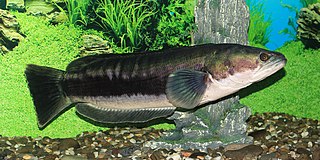
Channa is a genus of predatory fish in the family Channidae, commonly known as snakehead, native to freshwater habitats in Asia. This genus contains about 50 scientifically described species. The genus has a wide natural distribution extending from Iraq in the west, to Indonesia and China in the east, and parts of Siberia in the Far East. A particularly high richness of species exists in Myanmar (Burma) and northeastern India, and many Channa species live nowhere else. In contrast, a few widespread species have been introduced to several regions outside their natural range where they often become invasive. The large and medium-sized Channa species are among the most common staple food fish in several Asian countries and they are extensively cultured. Apart from their importance as a food fish, snakeheads are consumed in some regions as a traditional medicine for wound healing and reducing post-operative pain and discomfort, and collected for the international aquarium pet trade.

Dwarf snakehead is a term coined by aquarists to describe a group of Channa snakehead fishes growing to about 25 cm (10 in) maximum. They are found in freshwater habitats in South and Southeast Asia, and southern China.

Cyrtodactylus collegalensis, also known as the Kollegal ground gecko or forest spotted gecko, is a species of gecko found in and around Mysore hills, at the junction of the Western Ghats and the Eastern Ghats, in South India. Recent taxonomic works and genetic studies revealed that the formerly-supposed genus is actually a subgenus of the widespread genus Cyrtodactylus. It is often confused with the forest spotted gecko.
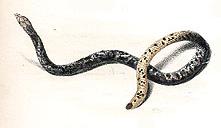
Rhinophis is a genus of nonvenomous shield tail snakes found in Sri Lanka and South India. Currently, 24 species are recognized in this genus. Of the 24 species, 18 are endemic to Sri Lanka, while 6 are endemic to South India.

The Cicadinae are a subfamily of cicadas, containing the translucent cicadas. They are robust cicadas and many have gaudy colors, but they generally lack the butterfly-like opaque wing markings found in many species of the related Tibiceninae.

Garra is a genus of fish in the family Cyprinidae. These fish are one example of the "log suckers", sucker-mouthed barbs and other cyprinids commonly kept in aquaria to keep down algae. The doctor fish of Anatolia and the Middle East belongs in this genus. The majority of the more than 140 species of garras are native to Asia, but about one-fifth of the species are from Africa.

Platypleura is a genus of cicadas that occurs widely across Africa and southern Asia. Some of the South African species are remarkable for their endothermic thermoregulation that enables crepuscular signalling, an adaptation that reduces risk of predation and enables a greater range for their calls. In field experiments their maximum body temperature while calling at dusk, was measured at 22 °C above ambient temperature.
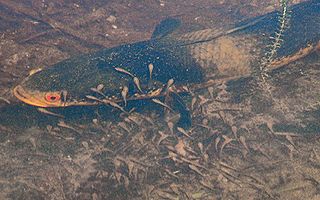
Channa marulius is a large species of snakehead native to South Asia. Populations in Southeast Asia are now regarded as separate species. It has been introduced to the United States, where it is considered an invasive species.
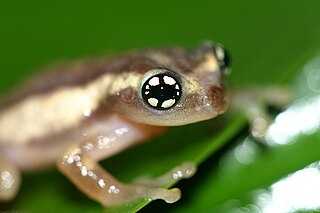
Raorchestes ochlandrae is a species of shrub frog in the family Rhacophoridae. It is endemic to the Western Ghats, India. This species of the oriental shrub frog was first described from Kakkayam Reserve Forest of Calicut district, Kerala state, in the southern Western Ghats in 2007 but has since been recorded at many other sites along the Western Ghats. The specific name ochlandrae refers to microhabitat of the species, bamboo Ochlandra setigera.

Pethia is a genus of small freshwater fish in the family Cyprinidae native to South Asia, East Asia(only Pethia stoliczkana recorded)and Mainland Southeast Asia. Some species are commonly seen in the aquarium trade. The name Pethia is derived from the Sinhalese "pethia", a generic word used to describe any of several small species of cyprinid fishes. Most members of this genus were included in Puntius, until it was revised in 2012.

Raorchestes is a genus of frogs in the subfamily Rhacophorinae that can be found in South and Southeast Asia, from southern India to Nepal, Myanmar, Thailand, and Laos to southern China and Vietnam and West Malaysia. They are particularly diverse in the Western Ghats of India. Only four species from the genus have been reported from southeast Asia and China, of which the third was reported as a range extension from Myanmar in 2019. Before the description of the genus in 2010, species now in Raorchestes had been assigned to genera Ixalus, Philautus, and Pseudophilautus. A recent study places Raorchestes as a sister taxon of Pseudophilautus.

Tyrannomyrmex is a rare tropical genus of ants in the subfamily Myrmicinae. Three similar species, only known from workers, are recognized and share small eyes and edentate mandibles.

Indolestes gracilis is a species of damselfly in the family Lestidae. It is known only from Sri Lanka, South India and Cambodia.
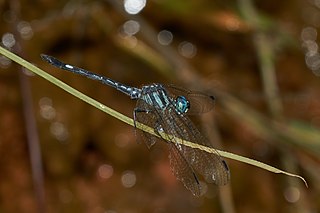
Hylaeothemis apicalis is a species of dragonfly in the family Libellulidae, endemic to India.

Tyrannomyrmex alii is a species of tropical ant in the subfamily Myrmicinae. T. alii is native to the Western Ghats in India. The species was described from workers and a winged queen, the first Tyrannomyrmex species in which a queen has been described, while the males are not known. Three additional species are also known, with one also being native to the Western Ghats.

Dutta’s Mahendragiri gecko is a species of large gecko found in Andhra Pradesh in India.

The forest spotted gecko or Erode ground gecko is a species of gecko that is endemic to hills of South India, in parts of Eastern Ghats and Western Ghats. It was first described from hills near Erode in Tamil Nadu in 1870. Subsequently, this species was thought to be similar to Cyrtodactylus collegalensis, but recent studies have confirmed that they are distinct. This species has been sighted in hills around Coimbatore, Tirupur and Erode, in parts of the Eastern Ghats in Tamil Nadu.
Hypselobarbus bicolor is a species of cyprinid in the genus Hypselobarbus. Its habitat is in the Indian Western Ghats and it was described in 2016.



















